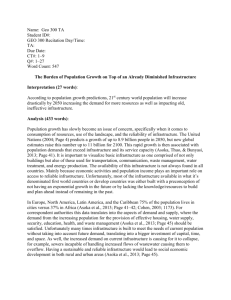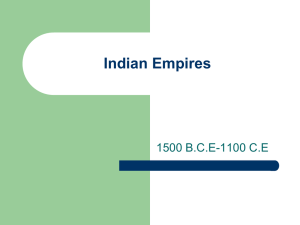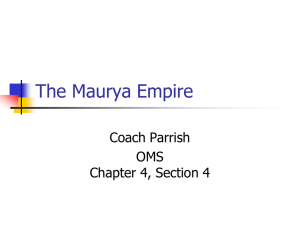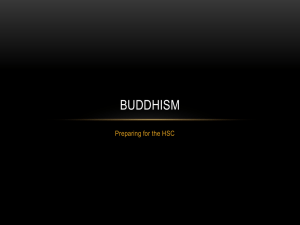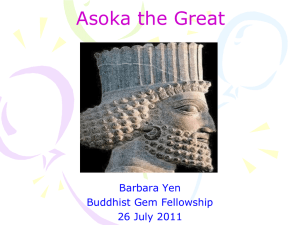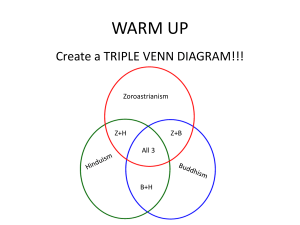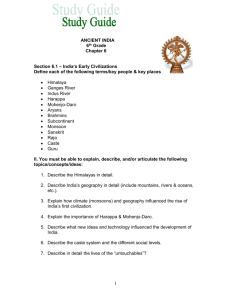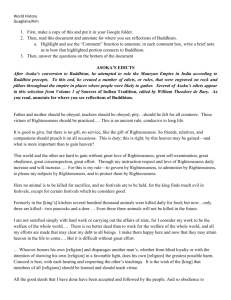ASOKA'S DHAMMA: TESTIMONY OF MONUMENTS
advertisement
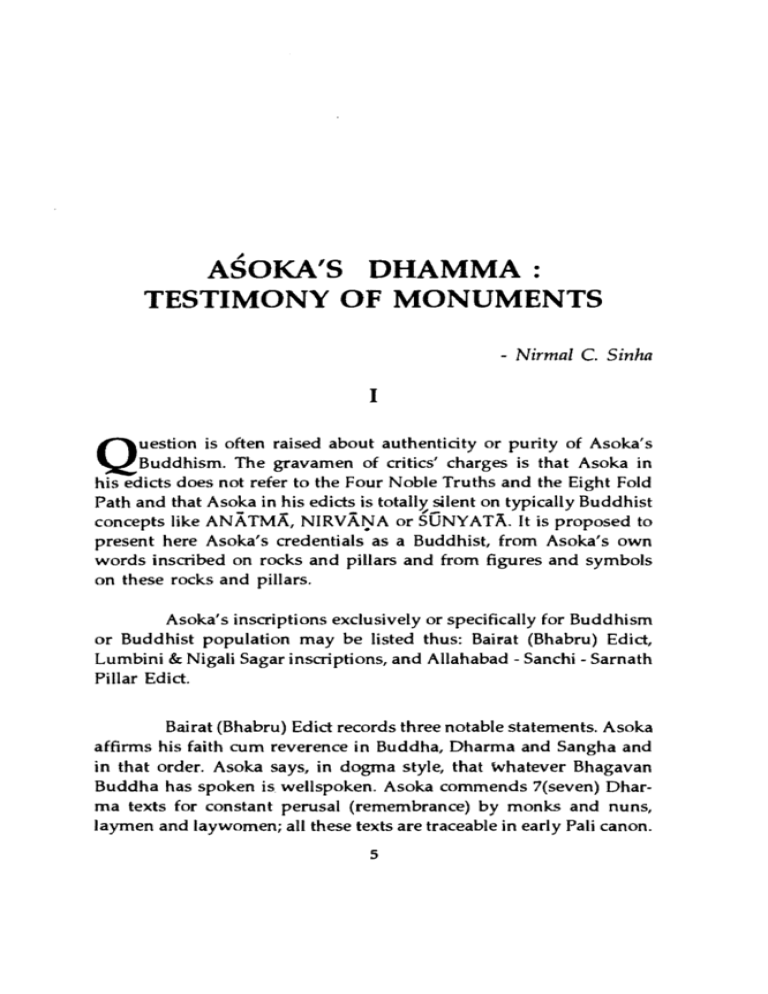
ASOKA'S DHAMMA: TESTIMONY OF MONUMENTS - Nirmal C. Sinha I uestion is often raised about authenticity or purity of Asoka's Buddhism. The gravamen of critics' charges is that Asoka in his edicts does not refer to the Four Noble Truths and the Eight Fold Path and that Asoka in his edicts is totally, silent on typically Buddhist concepts like ANATMA, NIRVAtJA or SUNYATA. It is proposed to present here Asoka's credentials as a Buddhist, from Asoka's own words inscribed on rocks and pillars and from figures and symbols on these rocks and pillars. Q Asoka's inscriptions exclusively or specifically for Buddhism or Buddhist population may be listed thus: Bairat (Bhabru) Edict, Lumbini & Nigali Sagar inscriptions, and Allahabad - Sanchi - Sarnath Pillar Edict. Bairat (Bhabru) Edict records three notable statements. Asoka affirms his faith cum reverence in Buddha, Dharma and Sangha and in that order. Asoka says, in dogma style, that whatever Bhagavan Buddha has spoken is wellspoken. Asoka commends 7(seven) Dharma texts for constant perusal (remembrance) by monks and nuns, laymen and laywomen; all these texts are traceable in early Pali canon. 5 Lumbini Pillar Inscription tt:lls us that Asoka made pilgrimage in 20th regnal year to the spot, where Buddha Bhagavan waS' bomi that Asoka set up the stone pillar to mark the spot; and that Asoka made the village Lumbini free of taxes and reduced its cropshare for the kind to an eighth. Nigali Sagar Pillar Inscription tells us that Asoka, in 20th regnal year, made' pilgrimage to the Stupa of Kanakamuni, a precursor Buddha and that earlier, in 14th regnal year, Asoka had enlarged the Stupa to double of its original size. The edict inscribed on pillars at Allahabad, San chi and Sarnath is a command "that any monk or nun who shall break. up the Sangha must be made to put on white robes and to reside outside" (away from Sangharama). As protector of Dhamma Asoka made Sangha a solid body and penalised dissidence. Data yielded by the above four epigraphs lead to categorical conclusion that Asoka was Buddhist by profession and practice. Asoka avowed in public his reverence cum faith in Tri-Ratna. He designated Buddha Sakyamuni as Bhagavan, the highest epithet for a mortal in theist as well as atheist sects in ancient India. He made pilgrimage to Buddha's birth place and exempted the people dwelling there from taxes. He was deeply read in the canon - not yet systematically preserved - and proclaimed that all Buddha-Vachana was gospel truths. He made pilgrimage to the Stupa of a precursor Buddha. And he penalised any attempt to split the Sangha. Leaving aside the missions and projects to disseminate Dhamma all over, the facts listed above are sufficient to label Asoka as a Buddhist in denominational or sectarian sense. I use these terms to satisfy the critics of Asoka's Dhamma, and I do so with reservations as Asoka is much above such labels. 6 II Detractors of Asoka's Dhamma make much of the omission of Four Noble Tru ths and Eight Fold Path or of absolute silence on ANATMA, NIRVA~A AND SUNY AT A in the inscriptions of Asoka. I write at length on the entire subject elsewhere. In that detailed discussion I conclude that Asoka was not ignorant of the abstruse concepts of Non-Soul,Emancipation and Void, and that Asoka deliberately avoided any reference to these concepts in the edicts. Here in this article I contend, on the basis of sculptures and reliefs on Asokan monuments, that Asoka certainly had knowledge of Four Noble Truths, Eight Fold Path, Twelve Links of Existence etc. but would not exhibit that knowledge. Most famous of Asoka's symbols on stone is Dharmachakra on the round abacus below the capital of the pi\lar. This Dharmachakra has 24 spokes. Ancient Indian convention was that a wheel had 8 spokes, eight being an auspicious number both in Brahmanism and Buddhism. In Buddhism 'eight' symbolises Eight fold Path and symbolises doubly Four Noble Truths. So the spokes of Dharmachakra should be 'eight' or 'multiple of eight'. In some cases the Dharmachakra would have 12 (Le. 8+4) spokes emphasising Twelve Links of Existence. Asoka's Dharmachakra symbolises Triple Jewel, Four Noble Truths and Eight Fold Path; 24 is a multiple of 3A or 8. Theras and Lamas consider 24 as the L.C.M. of 3 and 8. If I point out that 24 is also multiple of 12, Theras and Lamas find this as symbolising twice Twelve Links of Existence. Lamas would add that 24 is multiple of 2 also and that 2 stands for Two Truths: Relative Truth and Absolute Truth. Theras may not agree because the concept of Two Truths propounded by Nagarjuna may not be as old as Asoka. Lamas and Theras hold that the concepts of Triple Jewet Four Noble Truths, Eight Fold Path and Twelve Links of Existence are as old as the Turning of Dharmachakra by Buddha Sakyamuni. 7 The recovered fragments of Dharmachakra as on the heads of four lions of Sarnath Pillar suggest 32 spokes and as such a multiple of Four (Noble Truths) and Eight(Fold Path). Theras and Lamas on being told this fully agree with me. Asoka depicted Four Noble Truths and Eight Fold Path on stone conspicuously but not loudly as his critics would have desired. The number of spokes was no doubt as per Asoka's specification and was not out of the imagination of the sculptors, whether foreign or native. Asoka could prescribe canonical texts both for clergy and lai ty and could certainly command the craftsmen to depict 'eight' multiplied by 'three' or 'eight' multiplied by 'four' within available space. Not less important than the' number symbols' are the' animal symbols' in Asokan art. The animals are elephant, bull, horse and lion. The elephant stands for the immaculate conception of Bud~ dha who in the form of white elephant had descended from the heaven in dream when Maya(Mother) was quite old and beyond the age of child bearing. The bull is the sign of nativity because Gautama Siddhartha (Le. Buddha) was born under the zodiacal sign of Taurus(Vrisha). Scholars who dispute the possibility of this zodiacal sign in summer (Vaisakha) full moon hold that Virsha is the sign of Mahapurusha in all Indian religions and should be taken as the mark of great being par excellence. The horse stands for the one born in the royal stables the same fullmoon night, which as a colt was the playmate of child Siddhartha, which later was Siddhartha's mount and which drew the chariot to the Four Sights which inspired Siddhartha to investigate into the roots of mankind's sufferings; the horse on the night of renunciation grew soft pads under the hoofs and thus made the exit from the palace noiseless. Thus horse, the mark of royalty, turned out to be the mark of renunciation. The lion 8 represents Sakyasinha (lion of Sakyas) who was lion of mankind, Narasinha or Narottama, "the best of bipeds". Lion symbolises majesty, here spiritual majesty. Four lions crouching back to back symbolise Dhamma's majesty around the four quarters. The question arises why the craftsmen, who could shape such exquisite figures of animals, did not attempt a figure of Bhagavan Buddha. The answer is this : Asoka was a Buddhist, an orthodox Buddhist so Asoka desisted from any attempt to make an image of Buddha. For Asoka would not defy Buddha's sentiments about iconic representation. Buddha had repeatedly enjoined his disciples not to adore his RUPAKAYA (Physical Form) but to adore his DHAMMAKAY A (Spiritual Form). Even an old disciple on death bed was reprimanded for his last wish to have a glimpse of Buddha; vide Vakkali episode in Digha-nikaya. Chinese travel accounts like that of Hiuen Tsang and Tibetan chronicles like that of Taranatha speak of Buddha images made in wood on the specifications of devotee kings like Prasenajit and Udayana. If true, such images were made for preservation and record and certainly not for public adoration and exhibition. Asoka, as an orthodox believer must have thought so when confronted with the contemporaneous Buddha images in wood. III Asoka desisted from making the Buddha-rupa though he had a number of master sculptors under command. These master sculptors were recruited on merit and not on racial grounds. Perhaps the majority of Asoka's craftsmen were Yavanas, that is, Greeks and Iranians. There has been a great debate to determine the racial stock of Asoka's sculptors. Scholars like Vincent Smith (History of Fine Art in India and Ceylon, Oxford 1930) upholding the foreign background of these artists are known as "imperialists". Scholars like Ananda 9 Coomaraswamy (History of Indian and Indonesian Art, London 1927) upholding the Indian background of these artists are known as "nationalists". In my submission both schools are totally blind to the basic quality of Buddhism. In Brahmanism, as later in Hinduism, the image maker should be a native and of the same religion. In Buddhism merit and not birth was the qualification for the image maker; caste or race of the image maker was immaterial in Buddhism. In this connection it needs be noted that Buddha Sakyamuni was the first prophet to expound spiritual knowledge to all men without distinction of caste, colour or race. In India Vedic sages preached for the people accepted as ARY A. Outside Confucius, Moses and Zoroaster preached to their respective kinsmen known as 'civilised' of' elect'. Buddha Sakyamuni had no such inhibition against outsiders. Right from the beginning Damma was therefore poised to be a universal creed. If all were eligible "to perceive Buddha's Teaching" all were eligible "to perceive Buddha's Form", Asoka addressed his edicts to SA VA LOKA/SA VA MUNISA and had no inhibition about Yavanas in drawing figures and symbols. Scholars like Mortimer Wheeler (in Ancient India, Vol IV) think that Asoka employed unemployed Yavanas settled in India. A more correct view would be that Asoka recruited his craftsmen on merit only. As in Dhamma so in Dhammavijaya (Asoka's description of his successful missionary work in Rock Edict XIII) there was no question of ARY A or YAVAN A. Mute monuments testify for all time that Devanampriya Priyadarsi Raja Asoka was a Buddhist first and a Buddhist last. _ 10
